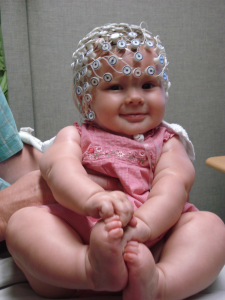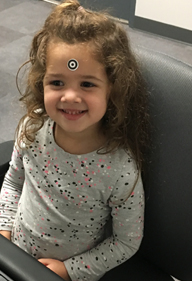The overarching goal of the research in the Brain, Cognition and Development Lab is to better understand how experience influences learning from infancy into childhood and when adults become perceptual experts. We use behavioral measures, eye-tracking methods, and measures of brain activity (event-related potentials) to better characterize factors that are important for learning and development as well as how such seemingly complicated computations are implemented in the brain and change over time and with experience. We collaborate with researchers locally, nationally, and internationally and our work has been funded by small local grants, the National Science Foundation and the US Army Research Institute for Behavioral and Social Sciences.
Perceptual Narrowing and Cortical Development in Infancy
 Face recognition is thought to be universal, an expert perceptual ability allowing us to effortlessly accomplish a variety of everyday activities, including identifying and differentiating individual people, emotions, gender, race, attractiveness, age, and intentions. Object recognition, also a ubiquitous skill, allows us to categorize, identify, and prioritize objects within the surrounding world. Although the end goal is similar (e.g., recognize someone or something in front of you), the processes and previous experiences necessary to recognize a face or an object differ and are influenced by many factors. This project has begun to elucidate the perceptual, cognitive, and social experiences that enhance or bias face and object perception and recognition and how such seemingly complicated computations are implemented in the developing brain.
Face recognition is thought to be universal, an expert perceptual ability allowing us to effortlessly accomplish a variety of everyday activities, including identifying and differentiating individual people, emotions, gender, race, attractiveness, age, and intentions. Object recognition, also a ubiquitous skill, allows us to categorize, identify, and prioritize objects within the surrounding world. Although the end goal is similar (e.g., recognize someone or something in front of you), the processes and previous experiences necessary to recognize a face or an object differ and are influenced by many factors. This project has begun to elucidate the perceptual, cognitive, and social experiences that enhance or bias face and object perception and recognition and how such seemingly complicated computations are implemented in the developing brain.
Using both cross-sectional investigations and longitudinal training designs, results from our research has clearly linked the development of face and object learning to experiences that highlight perceptual differences at the level of the individual. For example, when infants hear parents label two different dogs with individual-level names like ‘Oliver’ or ‘Suzie’ infants learn that it is likely important for them to attend to the visual details necessary to tell the two dogs apart. However, if parents label all dogs, “dog” infants learn to group them into a category and focus on the features that the two dogs share.
Exploring the Use of Visual Features and Recognition Strategies in Perceptual Expertise
 The defining quality of a perceptual expert is their keen ability to make fast, accurate identifications of objects from their domain of expertise at specific levels of categorization. A novice views a little brown creature with two legs and feathers and identifies it simply as a “bird” in contrast to the perceptual experience of a veteran birdwatcher who spots the same animal and knows in an instant that it is a “white crown sparrow.” As a signature of their perceptual skills, experts recognize objects of expertise at a more specific level whereas novices recognize objects at a generic level. In collaboration with Tim Curran (University of Colorado) and Jim Tanaka (University of Victoria) our studies aim to identify the visual characteristics and perceptual strategies that real world and laboratory-trained experts bring to bear when recognizing objects within their domain of specialization. Findings from these experiments should expand our understanding of the timing and magnitude of expertise training effects, the contribution of different stimulus features, the generalization of expertise, and whether individual differences contribute to training efficacy.
The defining quality of a perceptual expert is their keen ability to make fast, accurate identifications of objects from their domain of expertise at specific levels of categorization. A novice views a little brown creature with two legs and feathers and identifies it simply as a “bird” in contrast to the perceptual experience of a veteran birdwatcher who spots the same animal and knows in an instant that it is a “white crown sparrow.” As a signature of their perceptual skills, experts recognize objects of expertise at a more specific level whereas novices recognize objects at a generic level. In collaboration with Tim Curran (University of Colorado) and Jim Tanaka (University of Victoria) our studies aim to identify the visual characteristics and perceptual strategies that real world and laboratory-trained experts bring to bear when recognizing objects within their domain of specialization. Findings from these experiments should expand our understanding of the timing and magnitude of expertise training effects, the contribution of different stimulus features, the generalization of expertise, and whether individual differences contribute to training efficacy.
Face Processing in Young Children
 Face recognition is thought to be universal, an expert perceptual ability allowing us to effortlessly accomplish a variety of everyday activities, including identifying and differentiating individual people, emotions, gender, race, attractiveness, age, and intentions. This project seeks to elucidate the perceptual, cognitive, and social experiences that enhance or bias face perception and recognition and how such seemingly complicated computations are implemented in the developing brain. We hope to understand how experience with different faces outside of the lab affects how children perceive faces from different categories (e.g., males vs. females or adults vs. children) in the lab.
Face recognition is thought to be universal, an expert perceptual ability allowing us to effortlessly accomplish a variety of everyday activities, including identifying and differentiating individual people, emotions, gender, race, attractiveness, age, and intentions. This project seeks to elucidate the perceptual, cognitive, and social experiences that enhance or bias face perception and recognition and how such seemingly complicated computations are implemented in the developing brain. We hope to understand how experience with different faces outside of the lab affects how children perceive faces from different categories (e.g., males vs. females or adults vs. children) in the lab.